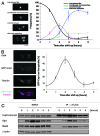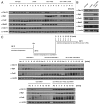An E2 enzyme Ubc11 is required for ubiquitination of Slp1/Cdc20 and spindle checkpoint silencing in fission yeast
- PMID: 23442800
- PMCID: PMC3637355
- DOI: 10.4161/cc.23946
An E2 enzyme Ubc11 is required for ubiquitination of Slp1/Cdc20 and spindle checkpoint silencing in fission yeast
Abstract
For ordered mitotic progression, various proteins have to be regulated by an ubiquitin ligase, the anaphase-promoting complex or cyclosome (APC/C) with appropriate timing. Recent studies have implied that the activity of APC/C also contributes to release of mitotic checkpoint complexes (MCCs) from its target Cdc20 in the process of silencing the spindle assembly checkpoint (SAC). Here we describe a temperature-sensitive mutant (ubc11-P93L) in which cell cycle progression is arrested at mitosis. The mutant grows normally at the restrictive temperature when SAC is inactivated, suggesting that the arrest is not due to abnormal spindle assembly, but rather due to prolonged activation of SAC. Supporting this notion, MCCs remain bound to APC/C even when SAC is satisfied. The ubc11 (+) gene encodes one of the two E2 enzymes required for progression through mitosis in fission yeast. Remarkably, Slp1 (a fission yeast homolog of Cdc20), which is degraded in an APC/C-dependent manner, stays stable throughout the cell cycle in the ubc11-P93L mutant lacking the functional SAC. Other APC/C substrates, in contrast, were degraded on schedule. We have also found that a loss of Ubc4, the other E2 required for progression through mitosis, does not affect the stability of Slp1. We propose that each of the two E2 enzymes is responsible for collaborating with APC/C for a specific set of substrates, and that Ubc11 is responsible for regulating Slp1 with APC/C for silencing the SAC.
Keywords: APC/C; Mad2; SAC; Slp1; Ubc11; mitosis; ubiquitin.
Figures





Similar articles
-
The spindle checkpoint functions of Mad3 and Mad2 depend on a Mad3 KEN box-mediated interaction with Cdc20-anaphase-promoting complex (APC/C).J Biol Chem. 2008 Aug 22;283(34):23039-47. doi: 10.1074/jbc.M803594200. Epub 2008 Jun 13. J Biol Chem. 2008. PMID: 18556659 Free PMC article.
-
Spindle checkpoint activation at meiosis I advances anaphase II onset via meiosis-specific APC/C regulation.J Cell Biol. 2008 Jul 28;182(2):277-88. doi: 10.1083/jcb.200802053. Epub 2008 Jul 21. J Cell Biol. 2008. PMID: 18644893 Free PMC article.
-
APC15 drives the turnover of MCC-CDC20 to make the spindle assembly checkpoint responsive to kinetochore attachment.Nat Cell Biol. 2011 Sep 18;13(10):1234-43. doi: 10.1038/ncb2347. Nat Cell Biol. 2011. PMID: 21926987 Free PMC article.
-
The spindle checkpoint: how do cells delay anaphase onset?SEB Exp Biol Ser. 2008;59:243-56. SEB Exp Biol Ser. 2008. PMID: 18368927 Review.
-
Cyclin A and Nek2A: APC/C-Cdc20 substrates invisible to the mitotic spindle checkpoint.Biochem Soc Trans. 2010 Feb;38(Pt 1):72-7. doi: 10.1042/BST0380072. Biochem Soc Trans. 2010. PMID: 20074038 Review.
Cited by
-
Mitotic checkpoint gene expression is tuned by codon usage bias.EMBO J. 2022 Aug 1;41(15):e107896. doi: 10.15252/embj.2021107896. Epub 2022 Jul 11. EMBO J. 2022. PMID: 35811551 Free PMC article.
-
C-terminal region of Mad2 plays an important role during mitotic spindle checkpoint in fission yeast Schizosaccharomyces pombe.Mol Biol Rep. 2017 Feb;44(1):89-96. doi: 10.1007/s11033-016-4083-y. Epub 2016 Sep 23. Mol Biol Rep. 2017. PMID: 27664031
-
MAPK-dependent control of mitotic progression in S. pombe.BMC Biol. 2024 Mar 25;22(1):71. doi: 10.1186/s12915-024-01865-6. BMC Biol. 2024. PMID: 38523261 Free PMC article.
References
Publication types
MeSH terms
Substances
LinkOut - more resources
Full Text Sources
Other Literature Sources
Molecular Biology Databases
